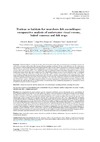Please use this identifier to cite or link to this item:
https://accedacris.ulpgc.es/handle/10553/35722
| Title: | Marinas as habitats for nearshore fish assemblages: comparative analysis of underwater visual census, baited cameras and fish traps | Other Titles: | Los puertos deportivos como hábitats para comunidades de peces litorales: análisis comparativo de censos visuales, cámaras con cebo y trampas para peces | Authors: | Bosch Guerra, Néstor Echedey Gonçalves, Jorge M. S. Tuya, F. Erzini, Karim |
UNESCO Clasification: | 251092 Acuicultura marina | Keywords: | Coastal development Marinas Habitat loss Fish assemblages Sampling methods, et al |
Issue Date: | 2017 | Journal: | Scientia Marina | Abstract: | Understanding the ecological role that artificial structures might play
on nearshore fish assemblages requires the collection of accurate and
reliable data through efficient sampling techniques. In this work,
differences in the composition and structure of fish assemblages between
the inner and outer sides of three marinas located in the temperate
northern-eastern Atlantic Ocean were tested using three complementary
sampling techniques: underwater visual censuses (UVC), baited cameras
(BCs) and fish traps (FTs). UVCs and BCs recorded a comparable number
and relative abundance of species, which in turn were much greater than
those recorded by FTs. This finding supports the use of UVCs and BCs
over FTs for broad ecologically studies, especially when dealing with
structurally complex habitats such as artificial structures. We found
differences in fish assemblage structure between the inner and outer
sides of marinas, independently of the sampling method. Four small-sized
species (Similiparma lurida, Thalassoma pavo, Sarpa salpa and Symphodus
roissali) associated with structurally complex vegetated habitats
dominated, in terms of abundance, the outer sides of marinas; Diplodus
vulgaris, Diplodus sargus and Gobius niger, species with high ecological
plasticity in habitat requirements, dominated the inner sides of
marinas. The information provided in this study is of great interest for
developing sound monitoring programmes to ascertain the effects of
artificial structures on fish communities. La comprensión de papel ecológico que las estructuras artificiales pueden desempeñar en las comunidades de peces litorales requiere la recolección de datos precisos y fiables, a través de técnicas de muestreo eficientes. En este trabajo, las diferencias en la composición y estructura de los poblamientos de peces entre las caras interior y exterior de tres puertos deportivos situados en el océano septentrional Atlántico templado se investigaron mediante tres técnicas de muestreo complementarias: censos visuales (UVC), cámaras con cebo (BC) y trampas para peces (FT). UVC y BC registraron un número comparable de especies y abundancias relativas, que fueron mucho mayores que las registradas por FT. Esta mayor cantidad de datos recogidas apoya el uso de estas técnicas sobre FT en estudios ecológicos, especialmente cuando se trata de hábitats de elevada complejidad estructural como el caso de estructuras artificiales. Encontramos diferencias en los poblamientos de peces entre las caras interior y exterior de los puertos deportivos, independientemente del método de muestreo. Cuatro especies de pequeño tamaño (Similiparma lurida, Thalassoma pavo, Sarpa salpa and Symphodus roissali), asociadas a hábitats vegetales estructuralmente complejos, dominaron, en términos de abundancia, las caras exteriores de los puertos deportivos; Diplodus vulgaris, Diplodus sargus y Gobius niger, especies con alta plasticidad ecológica en los requerimientos del hábitat, dominaron las caras interiores. La información aportada en este estudio es de gran interés para desarrollar programas de monitoreo adecuados para determinar los efectos de las estructuras artificiales en las comunidades de peces. |
URI: | https://accedacris.ulpgc.es/handle/10553/35722 | ISSN: | 0214-8358 | DOI: | 10.3989/scimar.04540.20A | Source: | Scientia Marina [ISSN 0214-8358], v. 81 (2), p. 159-169, (Enero 2017) | URL: | http://dialnet.unirioja.es/servlet/articulo?codigo=6041926 |
| Appears in Collections: | Artículos |
SCOPUSTM
Citations
10
checked on Jun 8, 2025
WEB OF SCIENCETM
Citations
9
checked on Jun 8, 2025
Page view(s)
110
checked on Nov 9, 2024
Download(s)
166
checked on Nov 9, 2024
Google ScholarTM
Check
Altmetric
Share
Export metadata
Items in accedaCRIS are protected by copyright, with all rights reserved, unless otherwise indicated.
